Explore topic-wise InterviewSolutions in .
This section includes InterviewSolutions, each offering curated multiple-choice questions to sharpen your knowledge and support exam preparation. Choose a topic below to get started.
| 1301. |
Describe J.J. Thomson's experiment on dischargephenomenon. What are the observations and the conclusions from this experiment? |
| Answer» | |
| 1302. |
A device called oscillator is used to send waves along a stretched string. The string is 20cm long, and four complete waves fit along its length when the oscillator vibrates 30 times per second. For the waves on the string: (a) what is their wavelength? (b) what is their frequency? (c) what is their speed? |
|
Answer» |
|
| 1303. |
You are given a magnetised bar and a compass needle. How will you mark polartiy at the ends of the bar ? |
| Answer» Solution :The TWO ends of the bar are brought NEAR the north pole of the COMPASS needle ONE by one. The end of the bar which repels the north pole of the compass needle will be the north pole, while the end of the bar which attracts the north pole of the compass needle will be the south pole. | |
| 1304. |
Heating effect of current is called…… |
|
Answer» JOULE heating |
|
| 1305. |
The numerical ratio of displacement to distance for a moving object is: |
|
Answer» ALWAYS LESS than 1 |
|
| 1306. |
An object experiences a net zero external unbalance forces. Is it possible for the object to be travelling with a non-zero veloctiy ? If yes, state the conditions that must be placed on the magnitude and direction of the velocity. If no, provide a reason. |
| Answer» Solution :GREATER MAGNITUDE FORCES make the BODY to mvoe in the DIRECTION of resultant force. | |
| 1307. |
When an object is made to float in two different liquids of density d_(1)andd_(2), the lengths of the object seen above the liquid surface are l_(1)andl_(2), respectively. Which of the following is the correct alternative ? |
|
Answer» `d_(2)gtd_(1),ifl_(1)gtl_(2)` |
|
| 1308. |
The efficiencyof a simple machine havingmechanical advantage 5 is 80% . If the displacement of the effort in lifting a load by using the machine is 20 cm, find the displacement of the load. |
|
Answer» Solution :(i) Relation between mechanicaladvantage, VELOCITY ratio and efficiency (ii) Relation between MECHANICAL , advantage, velocity ratio and efficiency. (iii) Definitionof velocityratio . (iv) Displacement of the LOAD = 3.2 cm |
|
| 1309. |
Two identical blocks A and b of different materials float on water such that 90% of A and 15% of B remain submerged inside water. Compare: (i) density of A and B. |
|
Answer» SOLUTION :Given for block `A:V/V=90%=0.9` for block B: `v/V=15%=0.15` (i) If `rho_(A),rho_(B)` and `rho_(w)` are the densities of A,B and water then For block `A=v/V=(rho_(A))/(rho_(w))=0.9`…I For block `B=v/V=(rho_(E))/(rho_(w))=0.15` ………II DIVIDING eqn (i) by eqn (ii) we get `(rho_(A))/(rho_(B))=0.9/0.15=6:1` (ii) It V is the volume of each block `("UPTHRUST on A")/("Upthrust on B")=(Vrho_(A)g)/(Vrho_(B)g)=(rho_(A))/(rho_(B))=6:1` |
|
| 1310. |
Abhishek lives in society flats alongwith his parents. He is studying in class IX. For the last few days, his mother has been complaning that the milk being supplied by the milkman is not pure. When she talked to other neighbours, they told her that they are also facing the same problem. Abhishek through over this problem for a while. He then went to the market and purchased a glass instrument to check the purity of milk being supplied by the milkman. when milkman brought milk the next day, Abhishek took this milk in a tall vessel and placed the instrument in it vertically. He explained to the milkman how this instrument indicated that the milk was not pure, it was adulterated. The milkman admitted his fault and promised to supply pure milk in future. Abhishek told about this incident to all his neighbours. Ultimately all the households in the society flats purchased the instrument to test the purity of milk. (a) Name the instrument which was purchased by Abhishek to check the purity of milk. (b) Name the principle on which the above instrument works. (c) What substance is usually mixed with pure milk by the dishonest milkmen to adulterate it and increase their profit? (d) Which physical quantity of pure milk is used to detect the presence of the substance mixed in it (which is measured by the above instrument)? (e) How does the instrument purchased by Abhishek show the presence of the substance mixed in pure milk by the milkman? (f) Which position of the instrument placed in two containers of milk A and B (one by one) shows (i) pure milk, and (ii) adulterated milk? (g) What values are displayed by Abhishek in this episode? |
|
Answer» Solution :(a) Lactometer (It is used to find out the amount of water mixed in pure MILK). (b)Lactometer works on the principle of flotation. (c) Water is mixed with pure milk to ADULTERATE it. (d) Relative density (Relative density of pure milk is higher than that of impure milk containing water). (e) (i) Since the relative density of pure milk is higher, therefore, pure milk will exert more upward (buoyant) force on the lactometer bulb due to which lactometer will float higher (with more of its calibrated tube above the milk level) when placed in a container of pure milk. (ii) The relative density of water is lower than that of pure milk. So, when water is mixed with pure milk, then the relative density of adulterated milk becomes less than that of pure milk. Due to lower relative density, adulterated milk EXERTS less upward (buoyant) force on lactometer bulb due to which lactometer will sink more and float at lower level when placed in a container of adulterarted milk. (f) (i) Container B contains pure milk (ii) Container A contains adulterated milk (containing water mixed in it). (g) The values displayed by Abhishek in this episode are (i) AWARENESS of the availability of lactometer to check the purity of milk (ii) KNOWLEDGE of principle of flotation and working of lactometer (iii) Idea of relative density of pure milk and water, and (iv) Desire to protect his family and neighbours from being cheated by dishonest milkma. |
|
| 1311. |
A spying plane flying over the sea has to make emergency landing due to some technical problem. The operator saw a huge ice block floating in the sea water is 15//17. If this plane weighs 360 kgwt and lands on this block, it is found that the ice block. |
|
Answer» Solution :Given the fraction of the ice block inside the SEA water `=(15)/(17)` `:.` ratio of the density of the ice block `(P_(i))` to the density of the sea water `(p_(w))=(15)/(17)` Let the density of ice block be `p_(i)=15X` Then density of the sea water `p_(w)=17X` Mass of the block kept on the ice block = 360 kg Let 'M' be the mass of the ice block. `:.M+360` = mass of water displaced = (volume of water displaced) `p_(w)` But the volume of water displaced = volume of the ice block = `(M)/(15x)` `:.M+360=((M)/(15x))(17x)=(17M)/(15)` `:.(17M)/(15)-M=360` `rArrM=(360xx15)/(2)=2700kg` `:.` mass of the ice block 2700 kg |
|
| 1312. |
……………… is a medical instrument used for listening to sounds produced in the body. |
|
Answer» |
|
| 1313. |
A rectangular wooden block has massof 4 kg .The length ,breadth and height of this wooden block are 50 cm,25 cm and 10 cm ,respectively .Find the pressure on the table top: ( a)When the wooden bock is kept with its surface measuring 50 cm xx 25 cm on the table . (b) When the woodenblock is kept with its sufarce measring 25 cm xx 10 cmon the table . (Assume : Acceleration due to gravity , (g=10 m/s^(2)) |
|
Answer» Solution :HereMass of WOODEN BLOCK m= 4kg Acceleration dur to gravity ,`g=10 m//s^(2)` Weightof wooden block ` W=mxxg ` `=4xx10` =40 N since weight is a force,so we can say that the force excerted by the wooden block on the table top is 40 N .We will now calculate the pressure in the two cases. 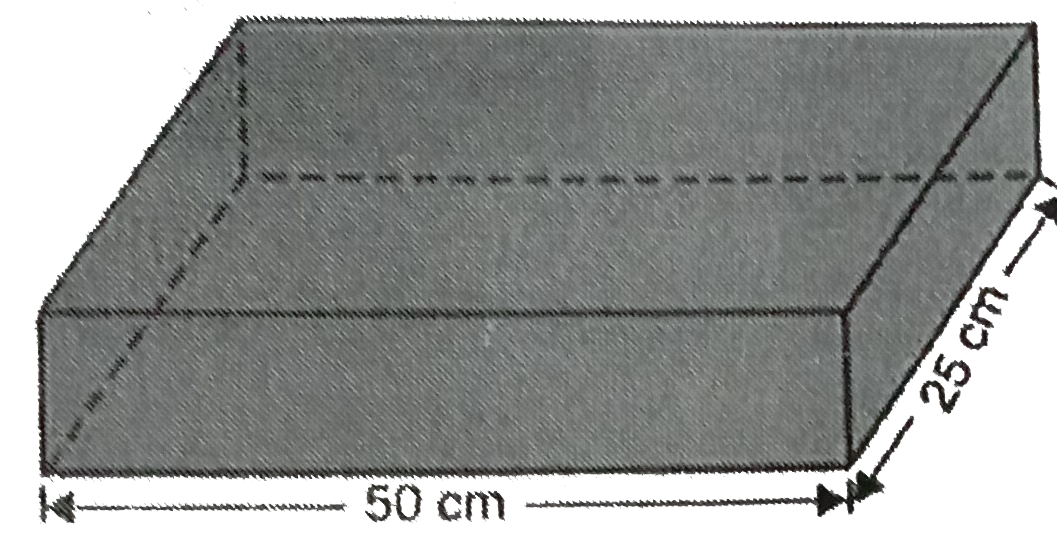 (a) In the first case :Force = 40 N(Calculated above) `AREA =50 cm xx 25 cm` `=(50)/(100) m xx (25)/ (100 )` `=0.5 m xx 0.25 m` ` = 0.125 m^(2)` Now Pressure ` =("Force")/("Area")` `=40/0.125` `=320 Nm^(2)`(or 320) Thus the pressure exerted by the wooden block on table top when kept on its face measuring `50 cm xx 25 cm ` is 320 `Nm^(-2)` of 320 pascals (see Figure 44) (b) In the second case : Force = 40 N(Same as above) Area `= 25 cm xx 10 cm` `=25 /100 mxx10/100 m` `=0.25 m xx 0.1 m` `=0.025 m^(2)` `Pressre = (Force)/(Area)` `=(40)/(0.025)` ` =1600 N m^(-2)` (or 1600) Thus the pressure exerted by the wooden block on table top when kept on its face measuring `25 cm xx 10 cm ` is 1600 N `m^(-2)` of 1600 pascals (see figure 45) 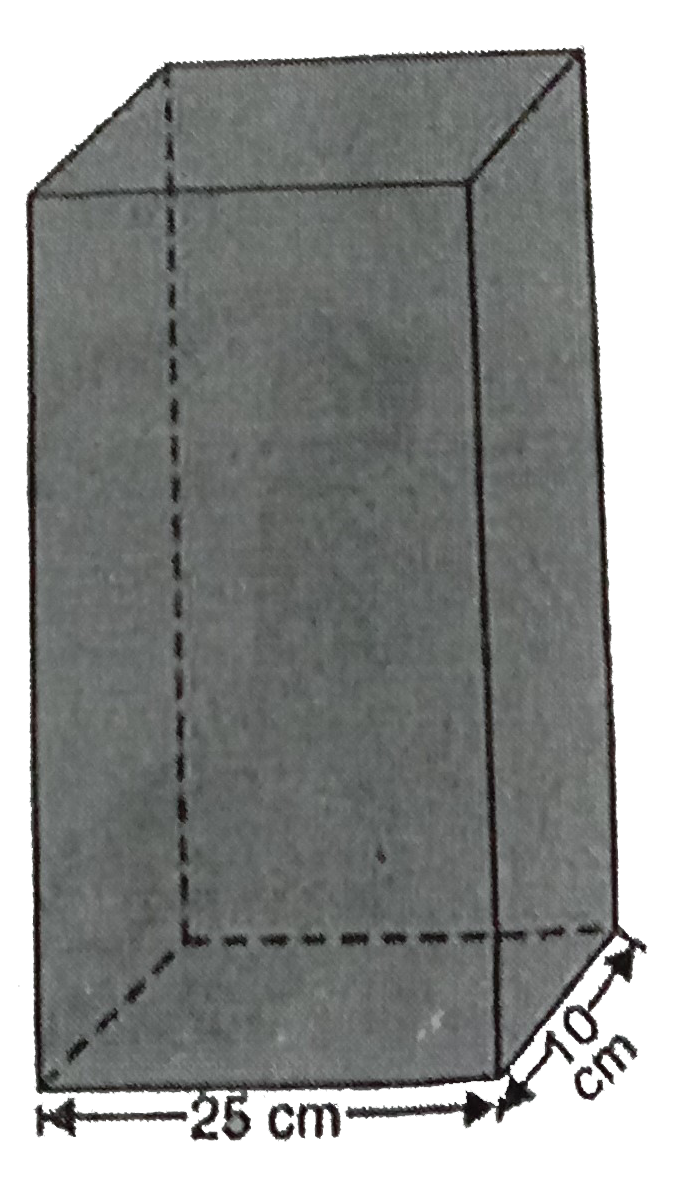
|
|
| 1314. |
For which range of frequencies, human ears are most sensitive ? |
| Answer» SOLUTION :2000 HZ to 3000 Hz | |
| 1315. |
Compare the time periods of a simple pendulum at places where g is 9.8 m s^(-2) and 4.36 m s^(-2) respectively . |
|
Answer» Solution :Given :`g_1= 9.8 m s^(-2)` , `g_2 = 4.36 m s^(-2)` Since `T PROP 1/SQRT(g) THEREFORE (T_1)/(T_2) = sqrt((g_2)/(g_1))` Or `(T_1)/(T_2) = sqrt((4.36)/(9.8)) = 1/(1.5) = 2/3` i.e., `T_2 : T_2 = 2:3 ` (or 0.667 :1) |
|
| 1316. |
Area under a velocity-time graph represents a physical quantity which has the unit ........ |
|
Answer» `m^(2)` |
|
| 1317. |
Two children are at opposite ends of an aluminium rod. One strikes the end of rod with a stone. Find the ratio of times taken by sound wave in air and in aluminium to reach the second child (Given: Speed of sound in air =346m//s, Speed of sound in aluminium = 6420m//s). |
|
Answer» Solution :Suppose the length of aluminium ROD is l. Then the distance travelled by sound in aluminium as well as in air to reach the second child will be equal to l. (i) SPEED of sound (in air) `= ("Distance travelled in air")/("Time taken in air")` ltbgt or `346 = (l)/("Time taken in air")` And, Time taken in air `= (l)/(346)` ...(1) (ii) Speed of sound (in aluminium) `= ("Distance travelled in aluminium")/("Time taken in aluminium")` or `6420 = (l)/("Time taken in aluminium")` And, Time taken in aluminium `= (l)/(6420)` .....(2) Now, dividing equation (1) by equation (2) we get: `("Time taken by sound in air")/("Time taken by sound in aluminium") = (l)/(346) xx (6420)/(l)` Cancelling l from the right side, we get: `("Time taken by sound in air")/("Time taken by sound in aluminium") = (6420)/(346)` `= (18.55)/(1)` Thus, the ratio of times taken by the sound waves in air and in aluminium to reach the second child (by TRAVELLING the same distance) is 18.55:1. |
|
| 1318. |
A car is fitted with a convex mirror of focal length 20 cm. Another car is 6 m away from the first car. Find the position of the second car as seen in the mirror of the first. What is the size of the image if the second car is 2 m broad and 1.6 m high? |
|
Answer» Solution :Focal length `= 20` cm (convex mirror) OBJECT distance `= -6 m = - 600 cm` IMAGE distance `v=?` `(1)/(f) = (1)/(u) + (1)/(v)` `(1)/(20) = (1)/(- 600) + (1)/(v)` `(1)/( v) = (1)/(20 )(1)/(-600) = (1)/(20) + (1)/(600) = (30+ 1)/(600) = (31)/(600)` `v= (600)/(31) = 19.35` cm (b) Size of the image `m = (-v)/(u ) = (v)/((-u)) = -(600)/(31) xx (1)/(-600) = (1)/(31)` BREADTH of image `= (1)/(31) xx 200 cm = 6.45 cm` Height of image ` - (1)/(31) xx 160 cm = 5.16 cm` |
|
| 1319. |
Which of the following relations is correct for a vehicle performing uniform accelerated motion? |
|
Answer» `V = (a)/(t)` |
|
| 1320. |
The observation of greenish-yellow light in the discharge tube at very low pressures led to the discovery of______rays. |
| Answer» | |
| 1322. |
Puta magneton a tableand placesomepaper clips nearby. Ifyoupushthe magnetslowlytowardsthe paper clipstherewill bea pointat whichthepaperclips jumpacrossandstickto themagnet.whatdo youunderstandfromthis ? |
Answer» SOLUTION :Theinvisiablemagneticfireldthatsurrounds the MAGNET actsat aparticulardistancethismagneticfieldattracts the paperclipwhichis MADE ofsteel . 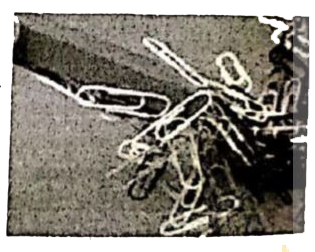
|
|
| 1323. |
Give a short note on Millikan's oil drop experiment. |
| Answer» | |
| 1324. |
Describe with diagram, how compressions and rarefactions are produced. |
Answer» Solution :Sound is also a longitudinal WAVE. Sound can travel only when there are particles which can be compressed and rarefied. Compressions are the regions where particles are CROWDED together. RAREFACTIONS are the regions of low pressure where particles are SPREAD apart. A sound wave is an example of a longitudinal mechanical wave. Below figure represents the longitudinal nature of sound wave in the medium. 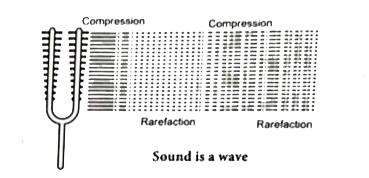
|
|
| 1325. |
State the direction of incident ray which after reflection from a spherical mirror retraces its path. Give reason for your answer. |
| Answer» Solution :When incident ray is directed towards the centre of curvature at all the POINTS of SPHERICAL mirror, the ray is ALWAYS normal. Therefore, angle of incidence i = Angle of reflection `R = 0^@`. | |
| 1326. |
Fill in the following blanks with suitable words : (a) If a body moves with uniform velocity, its acceleration is ……… . (b) The slope of a distance-time graph indicates …… of a moving body. (c ) The slope of a speed-time graph of a moving body gives its ....... (d) In a speed-time graph, the area enclosed by the speed-time curve and the time axis gives the ...... by the body. (e) It is possible for something to accelerate but not change its speed if it moves in a ...... |
| Answer» SOLUTION :(a) ZERO (B) SPEED (c ) acceleration (d) distance TRAVELLED (e) circular path | |
| 1327. |
The size of a particle is 4.6 mu . Express it in metre. |
|
Answer» SOLUTION :Given : Size of the particle = 4.6 `mu` SINCE 1 `mu` = `10^(-6) m ` `THEREFORE` Size of the particle `=4.6xx10^(-6)` m |
|
| 1328. |
The circular head of a screw gauge is divided into 50 divisions and the screw moves 1 mm ahead in two revolutions of the circular head. Find its least count. |
|
Answer» SOLUTION :Given, number of DIVISIONS on circular head = 50, and DISTANCE moved in two revolutions = 1 mm LEAST count = `("Pitch")/("Number of divisions on circular head")` `therefore L.C. =(0.05)/(50) = 0.001 cm` |
|
| 1329. |
The circular head of a screw gauge is divided into 50 divisions and the screw moves 1 mm ahead in two revolutions of the circular head. Find its pitch . |
|
Answer» Solution :GIVEN, NUMBER of divisions on circular head = 50, and distance MOVED in two revolutions = 1 mm Pitch = distance moved ahead in 1 revolution `= (1 mm)/(2) = 0.5 mm = 0.05` |
|
| 1330. |
If action is always equal to the reaction, explain how a horse can pull a cart. |
|
Answer» SOLUTION :A horse pushes the ground in the backwards direction. ACCORDING to Newton.s third law of of motion, a REACTION force is exerted by the EARTH on the horse in the FORWARD direction. As a result , the cart moves forward. |
|
| 1331. |
Dolphins bats and tortoiseuses |
| Answer» Answer :A | |
| 1332. |
A simple barometer tube contains some air in it. The length of the tube above the mercury level in the trough is 80 cm. The height of mercury in the tube is 71 cm at normal atmospheric pressure. What is the actual decrease in the atmospheric pressure if the barometer reads 65 cm ? |
|
Answer» Solution :FIND the length of the tube above the nercury level in the trough and HEIGHT of `H_(g)` in the tube normal ATMOSPHERE pressure `(P_(a))` Is the given barometer tube contains air in it ? Then, Is `P_(a)`= Pressure DUE to entrapped air `(P_(1))` and the height of Hg column ?(1) Take area of cross section of the tube as 'a'. Get the value of `'P_(1)'` from (1) Find the volume of entrapped air in the tube. Take in the tube. Take it as `'V_(1)'`. If barometer reads 65 cm of Hg column, then the atmosphere pressure `(Pa^(1))` is equal to 65 cm of Hg + pressure due to air entrapped in the tube `(P_(2))`. `"i.e.,"P_(a)^(1)=65cm+P_(2)""(2)` Now, find the volume of the air entrapped in the barometer tube. Take it as `'V_(2)'`. Find the value of `P_(2)` by using Boyle's law. `"i.e.,"P_(1)V_(1)=P_(2)V_(2)` `rArrP_(2)=(P_(1)V_(1))/(V_(2))` (3) Substitute the value of `'P_(2)'` in (2) and find the value of `P_(a)^(1)`. Then, actual decrease in atmospheric pressure will be equal to `(P_(a)-P_(a)^(1))`. |
|
| 1333. |
The distance covered by a car is known by the instrument ......... fitted in the car. |
| Answer» SOLUTION :ODOMETER | |
| 1334. |
How do X-rays detect a fracture in a bone? |
| Answer» | |
| 1335. |
In case of negative work, the angle between the force and displacement is : |
|
Answer» `0^@` |
|
| 1336. |
The melting of ice by application of pressure and its resolidification on releasing the pressure is known as _____. |
|
Answer» melting point |
|
| 1337. |
What value is given by the area of a region surrounded below the graph of v-t of a moving object in the given time period ? |
|
Answer» Distance |
|
| 1338. |
When the pressure of a gas is changed , then |
|
Answer» the density of the gas ALSO changes |
|
| 1339. |
A car is moving in a straight line with speed 18 km h^(-1) . It is stopped in 5 s by applying the brakes. Find : (i) the speed of car in m s^(-1), (ii) the retardation and (iii) the speed of car after 2 s of applying the brakes. |
| Answer» Solution :(i) `5 m s^(-1) ` (II) 1 m `s^(-2)` (III) 3 m `s^(-1)` | |
| 1340. |
Find the kinetic energy of a ball of 250 g mass, moving at a velocity of 40 cm/s. |
|
Answer» Solution :Mass of the BALL, m = 250 g =0.25 kg SPEED of the ball, V = 40 cm/s s = 0.4 m/s Kinetic energy, `K.E.= (1)/(2) (0.25) xx (0.4)^(2) = 0.02J` |
|
| 1341. |
Name any ten symbols with diagram. |
Answer» SOLUTION :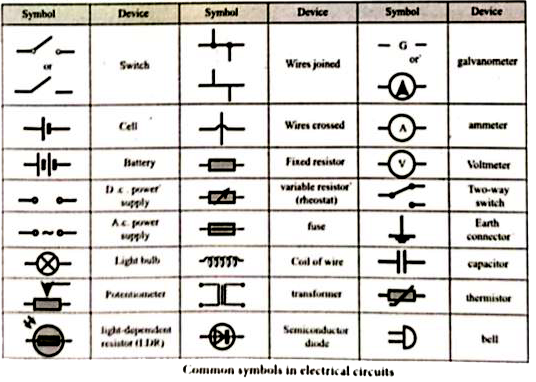
|
|
| 1342. |
Mohan and Sohan are two friends. Both study in class IX in differentschools. They have recently studied the chapter on force and motion in their class. Mohan plays criket in the school team whereas Sohan learns karate. On the sports day celebrations in Sohan's school, there was also an item of karate competition. Sohan invited Mohan to attend the sports day function because he was also taking part in karate competition. For the karate competition, the sports teacher had placed a number of tiles one over the other and supported them at both ends. There were five karate contestants. All the contestants were of almost the same age, same built and same weight. They were supposed to break all the tiles with just one blow of their hand. Each contestant was to be given only one chance for doing this. The first fourcontesting boys could not break the tiles with a single blow of their hand. They rather got their hands hurt badly. It was now Sohan's turn. Sohan hit the pile of tiles in the middle with a blow of his hand in such a way that all the tiles broke into pieces. All the people standing around started clapping. Mohan was very happy to see his friend win the competition. (a) Which physical quantity is involved in exerting force which breaks the pile of tiles in this competition? (b) Name two factors which multiply with each other to produce the above physical quantity. (c) Explain why, Sohan was able to break the pile of tiles with a single blow of his hand. (d) Why could the first four boys not break the pile of tiles with a single blow of their hand? (e) What values are displayed by Sohan in this episode? |
|
Answer» Solution :(a) Momentum (of the fast moving hand). (b) MASS (of hand) and velocity (of hand) multiply together to PRODUCE momentum. (c) Sohan strikes the PILE of tiles with hand very, vert fast. In doing so, the large momentum of the fast moving hand is reduced to zero in a very, very short time. This exerts a very force on the pile of tiles which is sufficient to break them apart. (d) The first four boys perhaps did not strike the pile of tiles with their hands very, vert fast. Since the velocity of hands was comparatively less, so the momentum created was less (which could not exert sufficient force to break the pile of tiles). (E) The values displayed by Sohan in this episode are (i) Awareness of the concept of momentum (ii) KNOWLEDGE that since the mass of hand is small, so to create a large momentum, the speed (or velocity) of moving hand has to be very, very large and (iii) Desire to win karate competition. |
|
| 1343. |
Name the experiment that determined the charge on electron. |
| Answer» | |
| 1345. |
For a floating body, its weight W and upthrust F_(B) on it are related as |
|
Answer» `WgtF_(B)` |
|
| 1346. |
A car is moving with the accelaration 2m/s^(2) from rest. Find the distance traveled by the car in 10th second. |
|
Answer» Solution :n = 10 s a= 2 m/`s^(2)` U = 0 m/s Substituting the values in the following equation `s_(n) = u + a [ n - (1)/(2) ] ` = 0 + 2`[ 10- (1)/(2) ] ` ` = 2 xx (21)/(2) ` = 21 m DISTANCE TRAVELED by the car in `10^(th)`s= 21 m. |
|
| 1347. |
{:("1) Pinna","a) Convert electrical signals"),("2) Eardrum","b) Transmits the amplified pressure"),("3) Middle ear","c) Sent to the brain"),("4) Cochlea" ,"d) Passes through the auditory canal."),("5) Auditory nerve", "e) Vibrates"):} |
|
Answer» |
|
| 1348. |
What are natural magnets? |
| Answer» SOLUTION :NATURAL MAGNETS exists in the nature and can be found in rocks and sandy deposits in various PARTS of the world. | |
| 1349. |
Define work |
| Answer» Solution :When a force ACTS on an object and the object MOVES in the direction of force, WORK is SAID to be done. | |
| 1350. |
Name the device which is used to produced sound in laboratory experiments. |
|
Answer» |
|